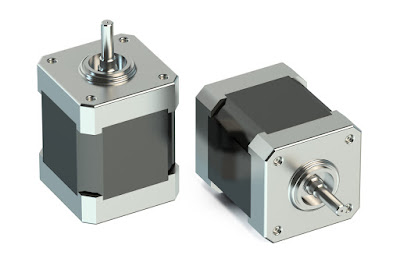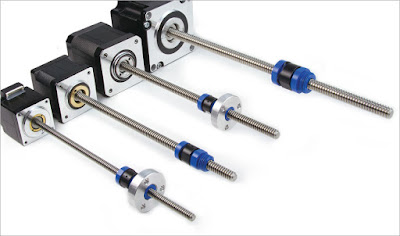Non-captive types of lead screw driven linear motor actuators
are different from the more common external versions in that they allow
the lead screw to completely pass through the motor. This fundamental
difference offers advantages for those that have limited space available
or are looking to shrink the overall size of their design package.
With an external actuator, the object being moved is mounted to the nut, and the screw rotates providing the motion along the length of the screw.
By contrast, in a non-captive actuator, the payload or object being moved is attached to the motor, and has screw ends that are typically fixed. In most cases, this setup can allow for a shorter overall screw to be used. It is also ideal for adding the external linear guide bearings that are almost always required for non-captive applications. They provide stiffness and eliminate deflection that causes premature wear on the nut, screw, and internal motor bearings.
A less common situation is where the device or payload is attached to the end of the screw. This is only used for very light loads and requires external linear guidance for stiffness. It is an arrangement that also requires clearance for the screw to extend out the opposite side of the motor.
One feature common to all non-captives is that the nut driving the screw is internal to the motor. Traditionally, this nut has been a standard nut with no mechanism to account for the play between the external threads of the screw and the internal threads of the nut. If, in this scenario, an anti-backlash capability was needed, manufacturers might be able to provide a custom solution, but with significantly higher cost and extended lead times.
To avoid this problem, PBC Linear offers the choice of a standard nut or anti-backlash nut within their non-captive linear actuators. We have the only anti-backlash nut and lead screw assembly available off-the-shelf in a non-captive configuration. This unique combination offers the best positional performance available in a non-captive hybrid actuator by utilizing our patented Constant Force Technology (CFT), which provides greater than two-times the superior backlash compensation as tested against competitors.
This advantage means that the self-lubricating nut will provide lubricant-free, consistent performance and preload over its lifetime. In addition, screws are available either uncoated or with a proprietary PTFE coating. These screws come with standard lead accuracy of 0.003 inches per foot, which is three-times better than typical screws on the market.
Non-captive linear actuators from PBC Linear go beyond the simple definition of motor and lead screw. They excel because they have been designed from the inside out, providing superior performance in linear motion applications.
With an external actuator, the object being moved is mounted to the nut, and the screw rotates providing the motion along the length of the screw.
By contrast, in a non-captive actuator, the payload or object being moved is attached to the motor, and has screw ends that are typically fixed. In most cases, this setup can allow for a shorter overall screw to be used. It is also ideal for adding the external linear guide bearings that are almost always required for non-captive applications. They provide stiffness and eliminate deflection that causes premature wear on the nut, screw, and internal motor bearings.
A less common situation is where the device or payload is attached to the end of the screw. This is only used for very light loads and requires external linear guidance for stiffness. It is an arrangement that also requires clearance for the screw to extend out the opposite side of the motor.
One feature common to all non-captives is that the nut driving the screw is internal to the motor. Traditionally, this nut has been a standard nut with no mechanism to account for the play between the external threads of the screw and the internal threads of the nut. If, in this scenario, an anti-backlash capability was needed, manufacturers might be able to provide a custom solution, but with significantly higher cost and extended lead times.
To avoid this problem, PBC Linear offers the choice of a standard nut or anti-backlash nut within their non-captive linear actuators. We have the only anti-backlash nut and lead screw assembly available off-the-shelf in a non-captive configuration. This unique combination offers the best positional performance available in a non-captive hybrid actuator by utilizing our patented Constant Force Technology (CFT), which provides greater than two-times the superior backlash compensation as tested against competitors.
This advantage means that the self-lubricating nut will provide lubricant-free, consistent performance and preload over its lifetime. In addition, screws are available either uncoated or with a proprietary PTFE coating. These screws come with standard lead accuracy of 0.003 inches per foot, which is three-times better than typical screws on the market.
Non-captive linear motor actuators from PBC Linear go beyond the simple definition of motor and lead screw. They excel because they have been designed from the inside out, providing superior performance in linear motion applications.
Source:https://blog.oyostepper.com/2019/12/31/deciding-when-to-use-a-non-captive-linear-actuator/
With an external actuator, the object being moved is mounted to the nut, and the screw rotates providing the motion along the length of the screw.
By contrast, in a non-captive actuator, the payload or object being moved is attached to the motor, and has screw ends that are typically fixed. In most cases, this setup can allow for a shorter overall screw to be used. It is also ideal for adding the external linear guide bearings that are almost always required for non-captive applications. They provide stiffness and eliminate deflection that causes premature wear on the nut, screw, and internal motor bearings.
A less common situation is where the device or payload is attached to the end of the screw. This is only used for very light loads and requires external linear guidance for stiffness. It is an arrangement that also requires clearance for the screw to extend out the opposite side of the motor.
One feature common to all non-captives is that the nut driving the screw is internal to the motor. Traditionally, this nut has been a standard nut with no mechanism to account for the play between the external threads of the screw and the internal threads of the nut. If, in this scenario, an anti-backlash capability was needed, manufacturers might be able to provide a custom solution, but with significantly higher cost and extended lead times.
To avoid this problem, PBC Linear offers the choice of a standard nut or anti-backlash nut within their non-captive linear actuators. We have the only anti-backlash nut and lead screw assembly available off-the-shelf in a non-captive configuration. This unique combination offers the best positional performance available in a non-captive hybrid actuator by utilizing our patented Constant Force Technology (CFT), which provides greater than two-times the superior backlash compensation as tested against competitors.
This advantage means that the self-lubricating nut will provide lubricant-free, consistent performance and preload over its lifetime. In addition, screws are available either uncoated or with a proprietary PTFE coating. These screws come with standard lead accuracy of 0.003 inches per foot, which is three-times better than typical screws on the market.
Non-captive linear actuators from PBC Linear go beyond the simple definition of motor and lead screw. They excel because they have been designed from the inside out, providing superior performance in linear motion applications.
With an external actuator, the object being moved is mounted to the nut, and the screw rotates providing the motion along the length of the screw.
By contrast, in a non-captive actuator, the payload or object being moved is attached to the motor, and has screw ends that are typically fixed. In most cases, this setup can allow for a shorter overall screw to be used. It is also ideal for adding the external linear guide bearings that are almost always required for non-captive applications. They provide stiffness and eliminate deflection that causes premature wear on the nut, screw, and internal motor bearings.
A less common situation is where the device or payload is attached to the end of the screw. This is only used for very light loads and requires external linear guidance for stiffness. It is an arrangement that also requires clearance for the screw to extend out the opposite side of the motor.
One feature common to all non-captives is that the nut driving the screw is internal to the motor. Traditionally, this nut has been a standard nut with no mechanism to account for the play between the external threads of the screw and the internal threads of the nut. If, in this scenario, an anti-backlash capability was needed, manufacturers might be able to provide a custom solution, but with significantly higher cost and extended lead times.
To avoid this problem, PBC Linear offers the choice of a standard nut or anti-backlash nut within their non-captive linear actuators. We have the only anti-backlash nut and lead screw assembly available off-the-shelf in a non-captive configuration. This unique combination offers the best positional performance available in a non-captive hybrid actuator by utilizing our patented Constant Force Technology (CFT), which provides greater than two-times the superior backlash compensation as tested against competitors.
This advantage means that the self-lubricating nut will provide lubricant-free, consistent performance and preload over its lifetime. In addition, screws are available either uncoated or with a proprietary PTFE coating. These screws come with standard lead accuracy of 0.003 inches per foot, which is three-times better than typical screws on the market.
Non-captive linear motor actuators from PBC Linear go beyond the simple definition of motor and lead screw. They excel because they have been designed from the inside out, providing superior performance in linear motion applications.
Source:https://blog.oyostepper.com/2019/12/31/deciding-when-to-use-a-non-captive-linear-actuator/











